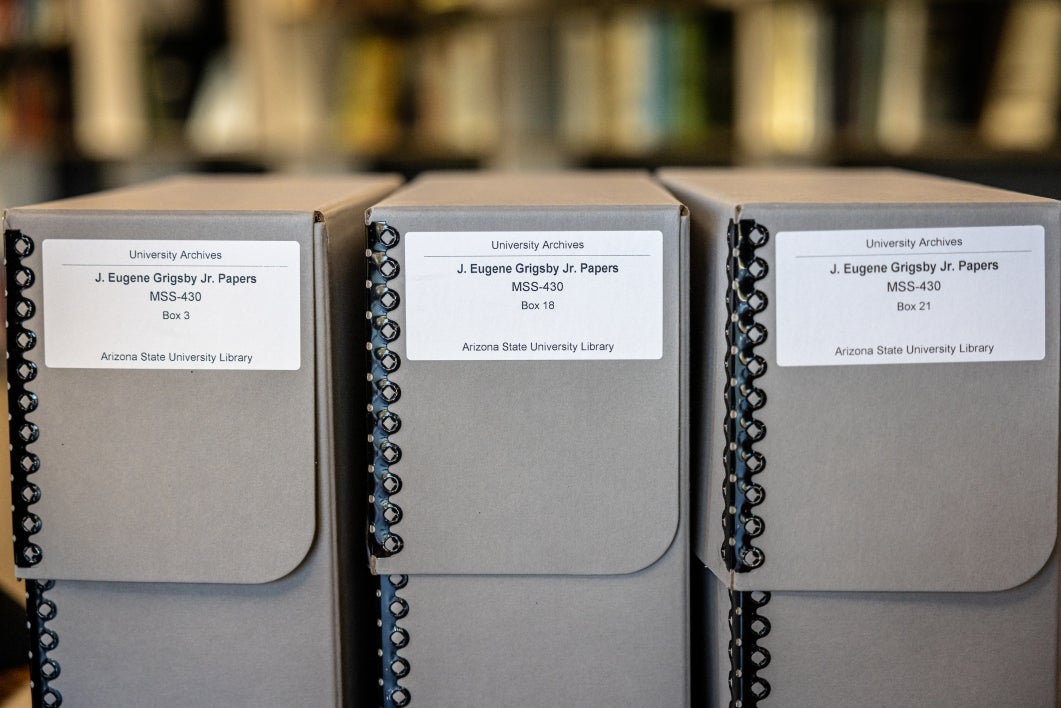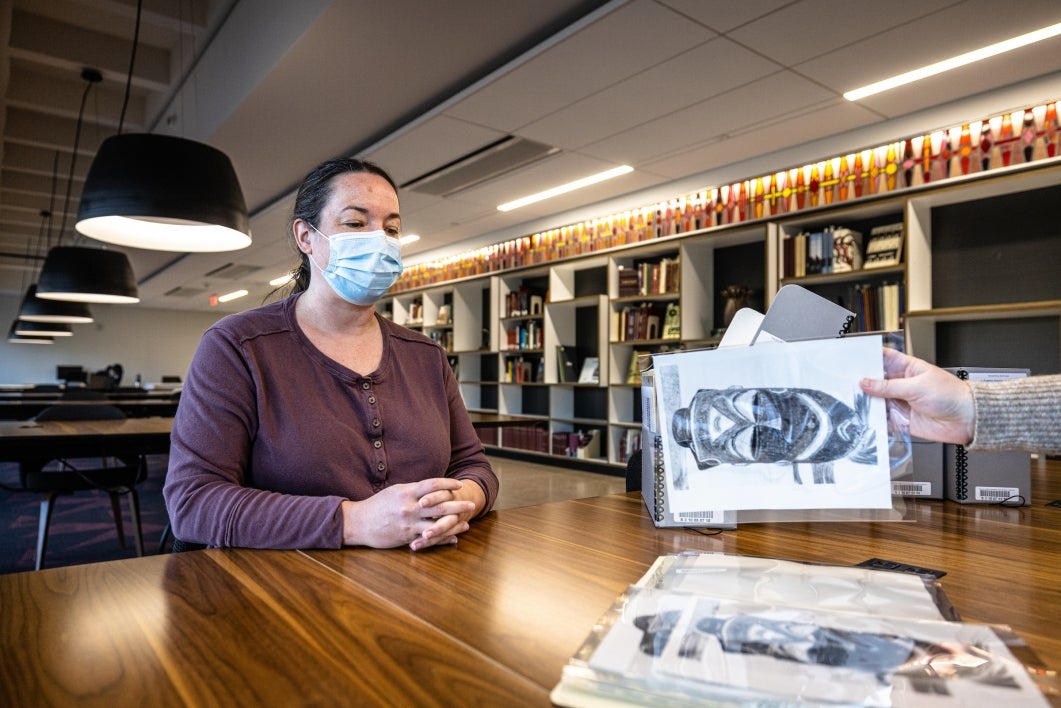While sorting through photos in the J. Eugene Grigsby Jr. Papers, one of many collections in the backlogs at ASU Library, Associate Archivist Elizabeth Dunham often joked that Grigsby was “a total dad.”
A teacher and an artist, he traveled often to national conferences and took pictures of everything that caught his eye along the way, from random buildings “right down to the pictures out the plane window,” Dunham said with a laugh.
Grigsby’s penchant for documentation may have been considered a charming character quirk during his lifetime, but today, it’s the reason ASU Library is able to offer a unique glimpse into the life of one of Arizona State University’s first Black professors in the fine arts department.
And it’s a long time coming for members of Arizona’s Black community, said Jessica Salow, who was recently named archivist of Black Collections at ASU Library, a new role for a new collection, both created as part of the university’s LIFT (Listen, Invest, Facilitate, Teach) Initiative.
Jessica Salow was recently named archivist of Black Collections, a new role for a new collection, both created as part of ASU’s LIFT (Listen, Invest, Facilitate, Teach) Initiative. Photo by Charlie Leight/ASU News
“It really was ... I'm going to use the word 'criminal' that we did not have a collection that documented Black life here in Arizona,” Salow said. “Because Black people have lived here forever, even before territory times.”
Per point 23 of a list of 25 actions ASU put forth in fall 2020 to address embedded injustices and structural problems within the institution and society at large, “ASU has committed to providing funding to sustain the Community-Driven Archives Initiative in the ASU Library in order to enhance the historical record of and the university’s and library’s engagement with underrepresented communities.”
Established in 2017 with the support of the Andrew W. Mellon Foundation, ASU Library’s Community-Driven Archives Initiative pulls from existing archival materials within the Greater Arizona Collection to create collections that highlight individuals and communities who have been historically underdocumented.
“Historically, ASU has not really focused on documenting marginalized communities,” Salow said. “(That kind of material) was just kind of shoved into the Greater Arizona Collection or university archives. So there really needs to be a reexamination of a lot of the ways that we classify and assign metadata to particular things in order to make them accessible.”
The Bj Bud Memorial Archives, the largest lesbian, gay, bisexual and transgender (LGBT) collection in Arizona, and Valley Friends of the Farm Workers Photographs, a collection documenting Arizona farmworker history and Cesar Chavez's "Fast of Love" in 1972, are just a couple to have come out of the Community-Driven Archives Initiative.
The J. Eugene Grigsby Jr. Papers is the first of the Black Collections to be arranged, described and made available for research via Arizona Archives Online.
The J. Eugene Grigsby Jr. Papers document the life and work of the influential Black fine arts professor. Photo by Charlie Leight/ASU News
“Particularly within the Black community, I've heard that people didn't even know we had archival material documenting Black life in Arizona, because it was either not classified as such or was misclassified,” Salow said. “So I really would just like to get the word out right now that we are starting work on Black Collections and that we want the Black community of Arizona to know that ASU is a partner with them in preserving that history.”
To that end, Salow will be hosting a Community Conversations event Thursday, Jan. 20, titled “A Look Inside Black Collections” that will share how the library’s Community-Driven Archives Initiative is expanding to document the lives of Black Arizonans and offer free resources, toolkits and archival materials.
“A large part of the work that I'm doing is building those relationships with members of the community, because the trust just isn't there yet,” Salow said. “So my purpose is to just listen, to learn and to impart my particular knowledge to people about how we can help and how this collection could benefit generations years down the line.”
The Community Conversations event is free and open to the public, and it will be held virtually via Zoom. For those who wish to learn more about becoming a community archivist and supporting efforts to preserve local history, resources covering everything from what it means to be an archivist to starter toolkits are also available online.
“It was already important to us to have these things available online for people who couldn’t be here in person for whatever reason, but especially with COVID, it’s even more important that we make these resources as accessible as possible,” Salow said.
Like Grigsby (who was born in North Carolina), Salow, a Pennsylvania native, also made her way out west later in life. Despite this, the affinity both she and Grigsby share for their adopted home is apparent.
The majority of the content in the Grigsby collection focuses on his life and work in Arizona, beginning when he was invited to teach art at the all-Black Carver High School in Phoenix in 1946. When Carver High School closed, Grigsby briefly taught at Phoenix Union High School before coming to ASU in 1966.
At ASU, Grigsby taught art education, particular art for high school, and served as the adviser to Give a Damn Art Teachers (GDAT), a student organization formed in the late 1960s to give students opportunities to interact with learners from a wide variety of ethnic and socioeconomic backgrounds.
ASU Library Associate Archivist Elizabeth Dunham shares some photos of African and Indigenous masks, the subject of Grigsby's doctoral dissertation and a good portion of the content of the collection. Photo by Charlie Leight/ASU News
A number of the photos in the Grigsby collection document various GDAT off-campus workshops, seminars, museum tours and student exhibits. Other materials in the collection include 35 mm color slides thought to be intended for class presentations, some of his own original works and materials related to his doctoral dissertation on African and Indian masks.
“Even now, I think his research interests are relevant to folks, because we’re still trying to understand culture, trying to understand identity, and that’s the same type of work Dr. Grigsby was doing,” Salow said.
On Monday, Feb. 21, Salow is planning to host an event to celebrate Black History Month that will go into more detail about the content of the Grigsby collection. Invited speakers include Grigsby’s son, Marshall, and ASU School of Art Professor Bernard Young, whom Grigsby recruited to the faculty.
“Dr. Grigsby had a really wide influence,” Salow said. “And this work is all about uplifting and making visible that hidden history that most people really don't know a lot about, internally to ASU and then also externally to the communities that surround ASU, because we need that.”
Keep an eye out for more information about the Feb. 21 event on the Community-Driven Archives Initiative website and social media platforms.
Top photo: Elizabeth Dunham (left), ASU Library associate archivist, and Jessica Salow, archivist for Black Collections, sort through slides from the J. Eugene Grigsby Jr. Papers, the first of the Black Collections to be arranged, described and made available for research via Arizona Archives Online. Photo by Charlie Leight/ASU News
More Arts, humanities and education

ASU professor's project helps students learn complex topics
One of Arizona State University’s top professors is using her signature research project to improve how college students learn science, technology, engineering, math and medicine.Micki Chi, who is a…

Award-winning playwright shares her scriptwriting process with ASU students
Actions speak louder than words. That’s why award-winning playwright Y York is workshopping her latest play, "Becoming Awesome," with actors at Arizona State University this week. “I want…

Exceeding great expectations in downtown Mesa
Anyone visiting downtown Mesa over the past couple of years has a lot to rave about: The bevy of restaurants, unique local shops, entertainment venues and inviting spaces that beg for attention from…





